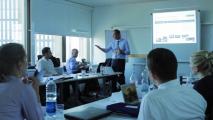Corporate Social Responsibility (CSR)
Corporate Social Responsibility has various faces. Several definitions are sworn by around the universe. In total most businesses already have a core understanding of what is meant with CSR. Van Merrewijk, 2001 e.g. defines it with: Companies with a CSR strategy integrate social and environmental concerns in their social business operations, in their interactions with their stakeholders and they openly demonstrate their triple P performances (The Concept and Definition of Corporate Social Responsibility).
The course started with an exercise. In the first step the students were asked to evaluate the standing of CSR, whether there are enough activities on CSR or whether there has to be an improvement regarding that topic, whether it is a thorough and approved concept or simply a marketing gag e.g. greenwashing. In a second step the students had to evaluate their knowledge regarding CSR. Thirdly the question was whose role should be increased and whose efforts should be stacked up - the government, the companies or the individuals.
Afterwards Mr. Merkes, Managing Director of Vineta Solutions, defined the term CSR, explained the guidelines (ISO26000, Global Reporting Initiative and the United Nations Global Compact) and how the awareness of companies has changed within the past few years. In former times companies invested in social projects, which were totally fragmented from their operating units. The result was often a mixture of uncoordinated CSR and philanthropic activities disconnected from the company`s strategy. Today the focus of these activities has switched more and more to supporting both their communities and their business goals. Companies should secure long-term economic performance by avoiding short-term behavior which is environmentally wasteful or socially detrimental. Corporate social responsibility has neatly implemented itself into the whole value chain of enterprises, may it be the reduction of waste or the equal treatment of employees around the globe.
For the companies there are different CSR drivers such as environmental needs, personal values, public and customer expectation, innovation, investor or rating agencies, differentiation and competition. Additionally, the varying stakeholder eg investors and evaluators, rule-makers and watch dogs, business partners and competitors, customer and consumer society has an influence on the CSR strategy of a company.
The second day started with a small wrap-up of the learning from the first day which was presented by a group of students. On the second day the lecturer further developed an understanding amongst the students about the six categories of the guideline ISO26000, such as human rights, labor practice, environment and so on. Furthermore the students learned how different companies embed CSR in their organization.
As guest lecturer, Dr. Wolfram Heger from Daimler AG presented the students insight into his challenge of how they implemented CSR in their company, according to which guideline Daimler is working and which CSR projects they have. The difficulties of CSR projects are often due to the different interests of the involved departments in a company and due to the fact that several CSR activities are not measureable. In group work the usefulness of the material matrix with which the benefit for the company can be compared with the societal benefits was deepened and visualized how it helps to meet confronting interests.
During the course the students were divided in three groups. Each group chose a company and analyzed the company`s CSR policy and guidelines. The students had to consider what CSR activities they would like to implement in that company. Afterwards the students presented the main goals which they wanted to achieve with their sustainability engagement and how they could measure the improvement of these activities for their company. The students defined the business case for their CSR activity within that company and tried to embed CSR in it. On the third day the different groups presented their gained CSR competencies from the session to the “board” of their company. The business case had to be defended by each group. The right strategy of convincing the CEO and its board members resulted in a tough role play.
Kerstin – IMP student








